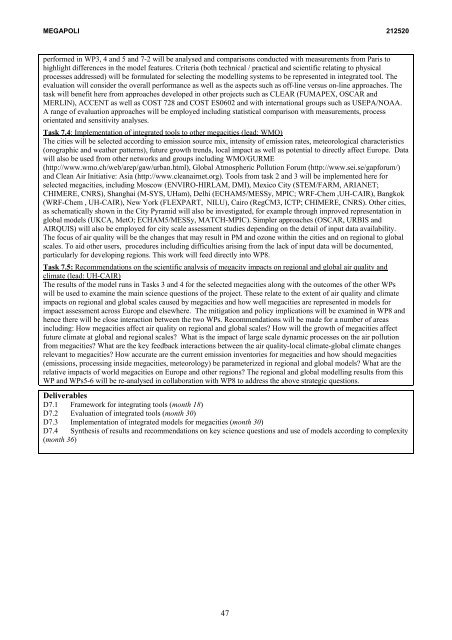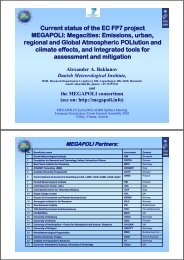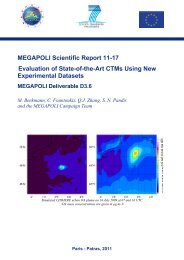D E S C R I P T I O N O F W O R K - MEGAPOLI - Dmi
D E S C R I P T I O N O F W O R K - MEGAPOLI - Dmi
D E S C R I P T I O N O F W O R K - MEGAPOLI - Dmi
You also want an ePaper? Increase the reach of your titles
YUMPU automatically turns print PDFs into web optimized ePapers that Google loves.
<strong>MEGAPOLI</strong> 212520<br />
performed in WP3, 4 and 5 and 7-2 will be analysed and comparisons conducted with measurements from Paris to<br />
highlight differences in the model features. Criteria (both technical / practical and scientific relating to physical<br />
processes addressed) will be formulated for selecting the modelling systems to be represented in integrated tool. The<br />
evaluation will consider the overall performance as well as the aspects such as off-line versus on-line approaches. The<br />
task will benefit here from approaches developed in other projects such as CLEAR (FUMAPEX, OSCAR and<br />
MERLIN), ACCENT as well as COST 728 and COST ES0602 and with international groups such as USEPA/NOAA.<br />
A range of evaluation approaches will be employed including statistical comparison with measurements, process<br />
orientated and sensitivity analyses.<br />
Task 7.4: Implementation of integrated tools to other megacities (lead: WMO)<br />
The cities will be selected according to emission source mix, intensity of emission rates, meteorological characteristics<br />
(orographic and weather patterns), future growth trends, local impact as well as potential to directly affect Europe. Data<br />
will also be used from other networks and groups including WMO/GURME<br />
(http://www.wmo.ch/web/arep/gaw/urban.html), Global Atmospheric Pollution Forum (http://www.sei.se/gapforum/)<br />
and Clean Air Initiative: Asia (http://www.cleanairnet.org). Tools from task 2 and 3 will be implemented here for<br />
selected megacities, including Moscow (ENVIRO-HIRLAM, DMI), Mexico City (STEM/FARM, ARIANET;<br />
CHIMERE, CNRS), Shanghai (M-SYS, UHam), Delhi (ECHAM5/MESSy, MPIC; WRF-Chem ,UH-CAIR), Bangkok<br />
(WRF-Chem , UH-CAIR), New York (FLEXPART, NILU), Cairo (RegCM3, ICTP; CHIMERE, CNRS). Other cities,<br />
as schematically shown in the City Pyramid will also be investigated, for example through improved representation in<br />
global models (UKCA, MetO; ECHAM5/MESSy, MATCH-MPIC). Simpler approaches (OSCAR, URBIS and<br />
AIRQUIS) will also be employed for city scale assessment studies depending on the detail of input data availability.<br />
The focus of air quality will be the changes that may result in PM and ozone within the cities and on regional to global<br />
scales. To aid other users, procedures including difficulties arising from the lack of input data will be documented,<br />
particularly for developing regions. This work will feed directly into WP8.<br />
Task 7.5: Recommendations on the scientific analysis of megacity impacts on regional and global air quality and<br />
climate (lead: UH-CAIR)<br />
The results of the model runs in Tasks 3 and 4 for the selected megacities along with the outcomes of the other WPs<br />
will be used to examine the main science questions of the project. These relate to the extent of air quality and climate<br />
impacts on regional and global scales caused by megacities and how well megacities are represented in models for<br />
impact assessment across Europe and elsewhere. The mitigation and policy implications will be examined in WP8 and<br />
hence there will be close interaction between the two WPs. Recommendations will be made for a number of areas<br />
including: How megacities affect air quality on regional and global scales? How will the growth of megacities affect<br />
future climate at global and regional scales? What is the impact of large scale dynamic processes on the air pollution<br />
from megacities? What are the key feedback interactions between the air quality-local climate-global climate changes<br />
relevant to megacities? How accurate are the current emission inventories for megacities and how should megacities<br />
(emissions, processing inside megacities, meteorology) be parameterized in regional and global models? What are the<br />
relative impacts of world megacities on Europe and other regions? The regional and global modelling results from this<br />
WP and WPs5-6 will be re-analysed in collaboration with WP8 to address the above strategic questions.<br />
Deliverables<br />
D7.1 Framework for integrating tools (month 18)<br />
D7.2 Evaluation of integrated tools (month 30)<br />
D7.3 Implementation of integrated models for megacities (month 30)<br />
D7.4 Synthesis of results and recommendations on key science questions and use of models according to complexity<br />
(month 36)<br />
47




